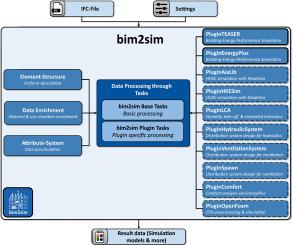Open-source framework for automated generation of building energy performance simulation models and beyond from BIM Data
IF 11.5
1区 工程技术
Q1 CONSTRUCTION & BUILDING TECHNOLOGY
引用次数: 0
Abstract
The manual creation of Building Energy Performance Simulation (BEPS) models is time-consuming and error-prone, hindering the implementation of energy-efficient building designs. This paper explores how to automate the generation of BEPS models from Building Information Modeling (BIM) data while addressing challenges of data imperfection and tool compatibility. bim2sim is presented as an open-source Python framework with a modular plugin architecture that processes Industry Foundation Classes (IFC) files to generate simulation models for various tools, including Modelica/TEASER and EnergyPlusWe present bim2sim, an open-source Python framework with a modular plugin architecture that processes Industry Foundation Classes (IFC) files to generate simulation models for various tools including Modelica/TEASER and EnergyPlus. The application to a non-residential building case study demonstrates the framework’s capability to produce functional simulation models at different levels of detail with significant time savings, reducing the time for generating simulation results from a BIM model to less than one hour. The framework benefits architects, building services engineers, and simulation engineers by streamlining the simulation workflow while maintaining OpenBIM compatibility. Future research should address remaining limitations in geometry processing and material mapping to further facilitate seamless information exchange between building design and simulation domains.

开源框架,用于自动生成建筑能源性能仿真模型和超越BIM数据
手工创建建筑能源性能模拟(BEPS)模型耗时且容易出错,阻碍了节能建筑设计的实施。本文探讨了如何从建筑信息建模(BIM)数据中自动生成BEPS模型,同时解决数据不完善和工具兼容性的挑战。bim2sim是一个开源Python框架,具有模块化插件架构,可以处理工业基础类(IFC)文件,为各种工具生成仿真模型,包括Modelica/TEASER和EnergyPlus。我们介绍bim2sim,一个开源Python框架,具有模块化插件架构,可以处理工业基础类(IFC)文件,为各种工具生成仿真模型,包括Modelica/TEASER和EnergyPlus。非住宅建筑案例研究的应用证明了该框架在不同细节级别上生成功能仿真模型的能力,大大节省了时间,将从BIM模型生成仿真结果的时间减少到不到一个小时。该框架简化了仿真工作流程,同时保持了OpenBIM的兼容性,从而使建筑师、建筑服务工程师和仿真工程师受益。未来的研究应解决几何处理和材料映射的剩余限制,以进一步促进建筑设计和模拟领域之间的无缝信息交换。
本文章由计算机程序翻译,如有差异,请以英文原文为准。
求助全文
约1分钟内获得全文
求助全文
来源期刊

Automation in Construction
工程技术-工程:土木
CiteScore
19.20
自引率
16.50%
发文量
563
审稿时长
8.5 months
期刊介绍:
Automation in Construction is an international journal that focuses on publishing original research papers related to the use of Information Technologies in various aspects of the construction industry. The journal covers topics such as design, engineering, construction technologies, and the maintenance and management of constructed facilities.
The scope of Automation in Construction is extensive and covers all stages of the construction life cycle. This includes initial planning and design, construction of the facility, operation and maintenance, as well as the eventual dismantling and recycling of buildings and engineering structures.
 求助内容:
求助内容: 应助结果提醒方式:
应助结果提醒方式:


